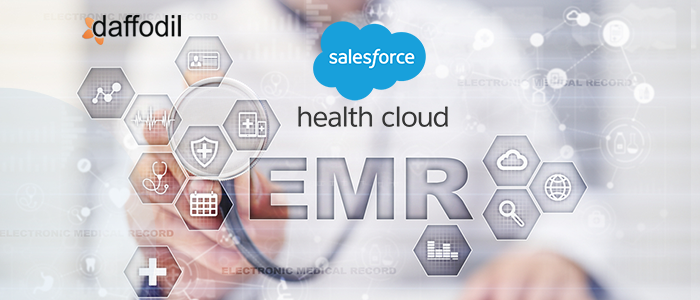
So, how does Salesforce Health cloud work with EMR data?
Salesforce Health cloud provides a 360-degree view of a patient’s history to the practitioners and other stakeholders in the healthcare industry.
By integrating Electronic Medical Record or EMR with the Health cloud doctors or clinicians can view the entire medical history of the patient including the previous diagnosis to treatments and this information can be further shared among peers for a better assessment of a patient’s file.
Health cloud makes the experience personalized at different levels for both patients and businesses. While it strengthens doctor-patient interactions, healthcare providers can build a better database of their patients.
Let’s explore how Salesforce Health Cloud-EMR integration benefits patients and healthcare providers.
What is Salesforce Health Cloud?
It is a unified platform that caters to both patients and the health service providers. While patients have better control over their medical journeys, their providers access data with a more insightful, personalized approach.
Essentially, it offers a deeper understanding of the patient to the providers with medical interactions they’ve had in the past, post-care experiences, and more. This vastly helps improve the services of care providers, businesses, to implement best practices for the optimal patient experience.
Also Read: How Salesforce Health Cloud can Improve Patient experience
What does Health Cloud do with EMR?
To break it down, Health Cloud overlaps EMR with CRM. How though? By giving access to EMR data within the CRM systems. It is this comprehensive data comprising clinical history and other records that makes the Health Cloud an absolute necessity for the healthcare industry. It gives out the true picture of a patient’s medical background to the providers so that they can diagnose well and give the best treatment possible.
Here are a few things that you should know about Health Cloud integrating EMR data into CRM:
-The built-in model of Health Cloud follows HL7 Fast Healthcare Interoperability Resources (FHIR) guidelines. Health Cloud ensures that it follows FHIR protocols with each release.
-The built-in services make it easy for the users and business owners to upload data into the Health Cloud. For older HL7 versions, users can seek HL7 vendor services to load data into the Health Cloud.
-Users can avail Salesforce Shield to encrypt data to secure patient information in compliance with the Health Insurance Portability and Accountability Act (HIPAA) post the uploading of the clinical records.
-The Health Cloud also gives an additional layer of security wherein you decide who sees the data with field-level security.
-The Health Cloud also accommodates the notes taken by nurses which don’t usually get uploaded in the EMRs as such.
Does Health Cloud diminish the role of EMR?
Not at all. A Health Cloud doesn’t mean you don’t need an EMR system anymore. An EMR can be used for maintaining patient conditions, treatments, CPT codes, and billing. While a Health Cloud should be used for non-treatment tasks for a simple reason – Health Cloud is majorly used by marketing, businesses, and analysts who are not directly related to the treatment as such.
Also Read: 5 ways Electronic Health Record (EHR) improves Patient experience
Looking to implement Salesforce Health Cloud?
Contact our experts today for Salesforce Health Cloud implementation, integration or support and maintenance. Whether it’s integrating the Health cloud with EHR/EMR or other systems such as HIM – enter a world of personalized experience while maintaining the optimal healthcare standards.



